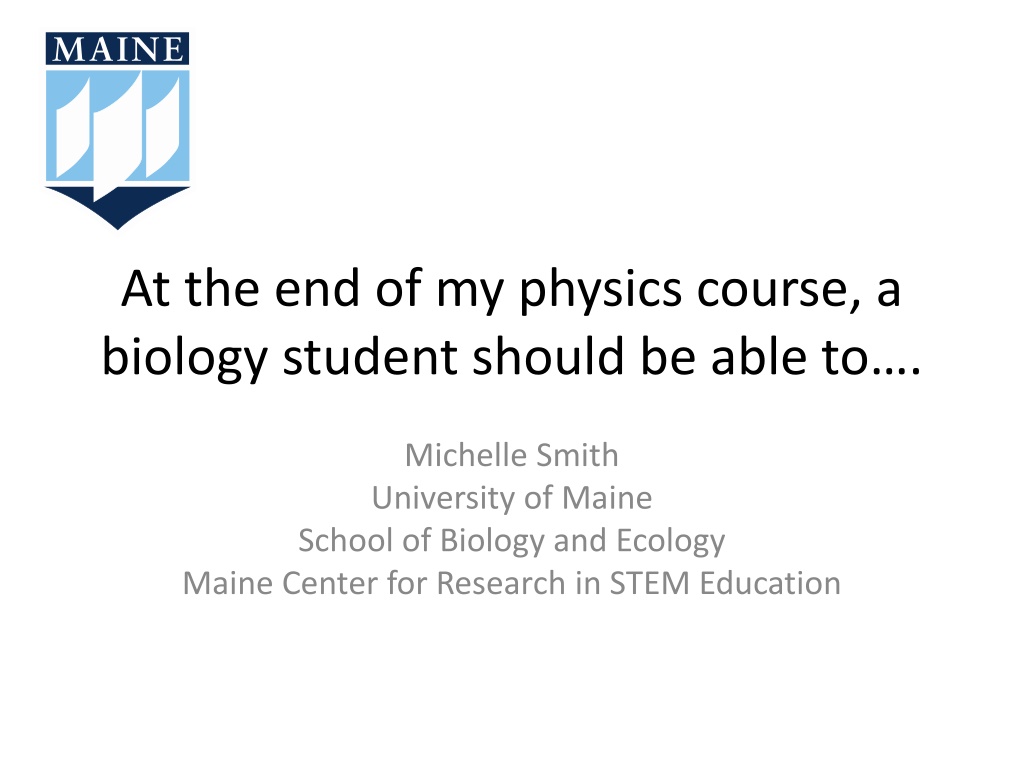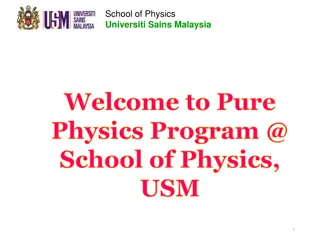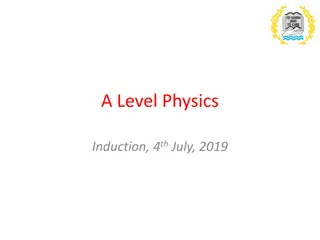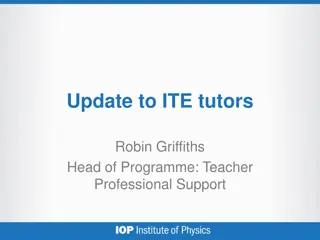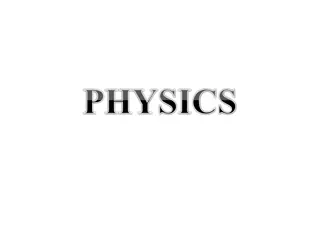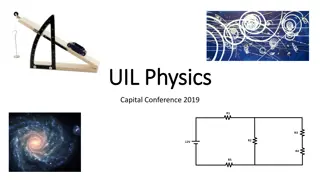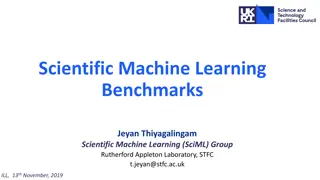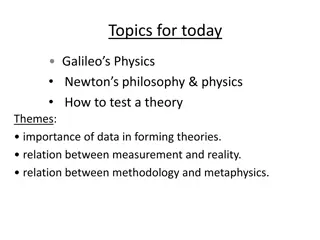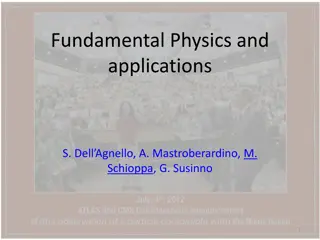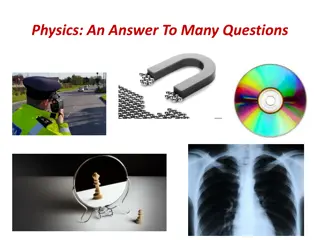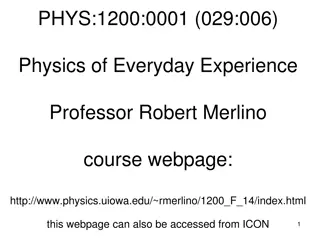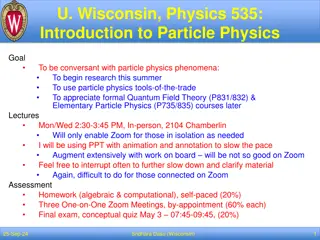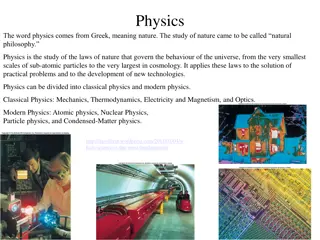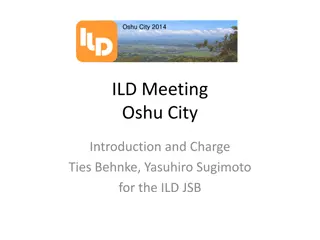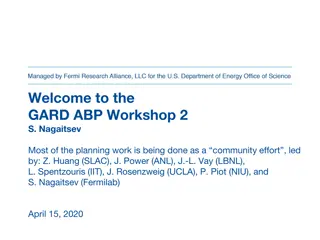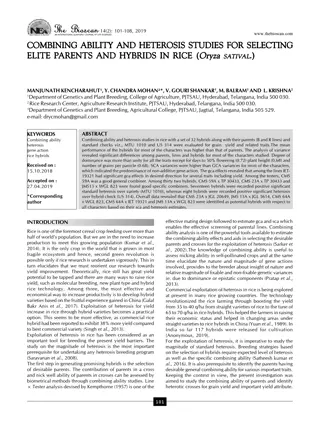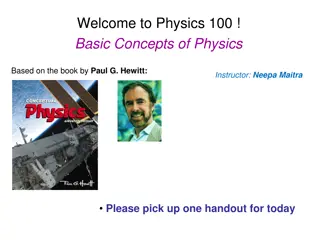Learning Goals in Physics for Life Sciences
Exploring the importance of learning goals in physics education for life sciences, this content emphasizes the need for measurable objectives that drive assessment and instruction. It touches on defining learning goals, distinguishing them from syllabi, and provides examples of how to structure clear and specific learning objectives to enhance student learning outcomes.
Download Presentation

Please find below an Image/Link to download the presentation.
The content on the website is provided AS IS for your information and personal use only. It may not be sold, licensed, or shared on other websites without obtaining consent from the author.If you encounter any issues during the download, it is possible that the publisher has removed the file from their server.
You are allowed to download the files provided on this website for personal or commercial use, subject to the condition that they are used lawfully. All files are the property of their respective owners.
The content on the website is provided AS IS for your information and personal use only. It may not be sold, licensed, or shared on other websites without obtaining consent from the author.
E N D
Presentation Transcript
At the end of my physics course, a biology student should be able to . Michelle Smith University of Maine School of Biology and Ecology Maine Center for Research in STEM Education
My Experience with Physics Me in college: -Biology major -Hoping to go to grad school in molecular biology -Good grades in high school science classes including physics Physics 100 Preparation for Exam 1: -Reworked sample problems over and over -Memorized equations -Studied for HOURS! C+
What Do I Remember about Physics 100? Bulb #1 battery Bulb #2 Bulb #3 Learned how to systematically approach problems
Outcomes Should Drive Assessment & Instruction How are you going to get there? Where are you going to? Where are you at? Backwards design
At the End of this Workshop You will be able to: -Explain the purpose of learning goals and objectives to your colleagues -Develop learning objectives for Introductory Physics for the Life Sciences -Characterize learning goals using Bloom s taxonomy
Learning Goals Definition: What students should be able to do after completing a course Requirement: Must be measurable assessment and goals tightly linked Your goals should reflect what you value in student learning
Learning Goals are Different from a Syllabus Learning goals: Outcome and student oriented: Syllabus/ Topic List Material covered (and time spent) Identifies what students will be able to do as a result of learning Defines what students are expected to learn Learning Goals (for a whole course) can be broad. At the topic or lecture level, the learning objectives should be more specific
Example Learning Goal General structure At the end of this course students should be able to SPECIFIC VERB -avoid vague verbs such as understand Genetics At the end of this course, students should be able to CALCULATE the probability that an individual in a pedigree has a particular genotype. Introductory Physics At the end of this course, students should be able to APPLY their knowledge of work and Newton's laws to common transportation systems (cars, bicycles etc.)
Brainstorm Ideas for Learning Goals for Introductory Physics for the Life Sciences Private Universe http://www.learner.org/resources/series28.html If a camera crew making a documentary on student misconceptions in physics were to question biology majors at graduation, what would you be most embarrassed to find out that they did not know? -Work with the people at your table -Designate a recorder and get the Working Group I document from the USB key -Share your thoughts in a small group and select 2-3 ideas you feel are most important Facilitators please pass out USB keys
How do we define learning goals? 1. At what level do we want students to know something? 2. What are the different types of things we want students to know?
Levels of Knowledge Bloom s Taxonomy, 1956 What level of understanding do you want them to gain? Higher-level cognitive skills Synthesis & Evaluation Analysis Higher cognitive orders Application Comprehension Lower cognitive orders Knowledge Lower-level cognitive skills
Bloom's Taxonomy of the Cognitive Domain (Levels of Learning) 1. Factual Knowledge: remember and recall factual information Define, List, State, Label, Name, Describe 2. Comprehension: demonstrate understanding of ideas, concepts Describe, Explain, Summarize, Interpret, Illustrate 3. Application: apply comprehension to unfamiliar situations Apply, Demonstrate, Use, Compute, Solve, Predict, Construct, Modify 4. Analysis: break down concepts into parts Compare, Contrast, Categorize, Distinguish, Identify, Infer 5. Evaluation: think critically about and defend a position Judge, Appraise, Recommend, Justify, Defend, Criticize, Evaluate 6. Synthesis: transform, combine ideas to create something new Develop, Create, Propose, Formulate, Design, Invent Higher level: Require deeper conceptual understanding Lists of verbs in the USB document
Writing Learning Goals Based on the Brainstorm Ideas At the end of my physics course, a biology student should be able to . Work with your group to write 1-2 learning goals based on the brainstorm ideas, file has sample verbs -Group recorders please record the group ideas Check-list for creating learning goals: Is goal expressed in terms of what the student will achieve or be able to do? Is the Bloom s level of the goal aligned with your actual expectations? Is the goal well-defined? Is it clear how you would measure achievement? Do chosen verbs have a clear meaning? Is terminology familiar/common? If not, is the terminology a goal? Is it relevant and useful to students? (e.g. connected to their everyday life OR does it represent a useful application of the ideas)
How do we define learning goals? 1. At what level do we want students to know something? 2. What are the different types of things we want students to know?
Different Types of Things we Want Students to Know FACTS: Terminology, information, details CONCEPTS Classifications, categories, principles, models, reasoning. Analyze, explain, and predict the world around you PROCEDURES: Skills, techniques, methods, problem-solving. Thinking like a scientist: Use alternative representations, compare and contrast, strategize, justify, design an experiment, create a graph. AFFECTIVE (attitudes & beliefs): Appreciate, enjoy, value. Recognize that the behavior of the world around you is not magical and mysterious, but rather can be understood and predicted using certain fundamental principles.
Learning Goals Focused on Problem Solving Some sample ideas: At the end of a physics course, biology students should be able to . 1. recognize which real-world problems are subject to mathematical reasoning 2. solve problems using general quantitative problem solving skills within the context of physics 3. solve problems using general qualitative logical reasoning within the context of physics In your small group, write at least one additional learning goal focused on problem solving Henderson et al., 2001 Instructors Ideas about Problem Solving
Thank You Workshop materials adapted from: Stephanie Chasteen Jenny Knight Carl Wieman More learning goal resources at http://www.colorado.edu/sei/fac- resources/learning-goals.html Please save the learning goals document on a USB key, appending your last name to the filename (do NOT overwrite any files on the USB key) or email to Bob Hilborn at rhilborn@aapt.org
